Lock, load, liftoff
Skyhawks are trainers for Iraq's new air force
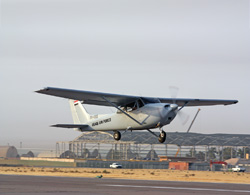 Headset? Check.
Headset? Check.
Kneeboard? Check.
Charts and checklists? Check.
Flack vest, M-16 rifle, side arm, extra ammunition, and survival gear? Check.
That’s not what a flight instructor would normally carry out to a Cessna 172 for a training flight with a primary student. But it’s become routine for the 13 instructor pilots of the U.S. Air Force’s 321st Air Expeditionary Wing, known as the Coalition Air Force Training Team (CAFTT) until the unit was renamed in November 2008. They are tasked with training members of Iraq’s new air force at a training base in Kirkuk, Iraq. Fixed-wing primary training is conducted in Thielert diesel-powered, Garmin G1000-equipped Cessna 172s.
Memorable mission
“I used to laugh at all the stuff we had to take out to fly a mission,” said Maj. Charles Shumaker, who served with the unit from August 2007 to August 2008. “The combat aspect of the job made it memorable—not always fun, but lugging all the weapons and the body armor to a 172 to fly a local sortie was different.”
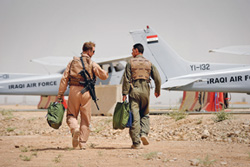 He said his year in Kirkuk was one he won’t soon forget. “As a flight instructor the chance to instruct folks in their own country, where English was not their primary language—some of them had never driven a car—and teaching them to fly in an area where bullets were still flying was memorable,” recalled Shumaker. “We tried to speak their language as best we could, and build a rapport with them. Considering their history over there, building a rapport was more important than if they were here.”
He said his year in Kirkuk was one he won’t soon forget. “As a flight instructor the chance to instruct folks in their own country, where English was not their primary language—some of them had never driven a car—and teaching them to fly in an area where bullets were still flying was memorable,” recalled Shumaker. “We tried to speak their language as best we could, and build a rapport with them. Considering their history over there, building a rapport was more important than if they were here.”
Additional foes
Heat is one of the biggest foes, said Capt. Dave Garvin, director of training. “It gets hot with a capital H out here in the summertime. You add our normal vest with our equipment; it weighs about 50 pounds on the average. And the vest does not breathe very well because it has plates in it. When you’re sitting in a Cessna 172, in an hour and a half of flight, you can get dehydrated in a very short amount of time.”
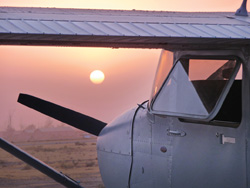 Before deploying to Iraq, Garvin taught in Columbus, Mississippi. “Our main concern around there was thunderstorms. Around here we hardly ever have a ceiling, but dust storms come through frequently.” On a recent flight he saw dust storms moving in from the north and west. “They came out of nowhere, and it was a race against time to get the airplanes on the ground before it went zero/zero.”
Before deploying to Iraq, Garvin taught in Columbus, Mississippi. “Our main concern around there was thunderstorms. Around here we hardly ever have a ceiling, but dust storms come through frequently.” On a recent flight he saw dust storms moving in from the north and west. “They came out of nowhere, and it was a race against time to get the airplanes on the ground before it went zero/zero.”
“Today is what I call our sepia day,” said Lt. Col. Nate Brauner, commander of the wing’s 52nd Expeditionary Flying Training Squadron. “We’ve got an orange tint to everything. The top visibility we’ve seen is a half-mile.” Visibility on a good summer day is five or six miles.
Brauner flew with a student recently who had not flown in good weather, and they were aloft on a day when the visibility was 11 miles. They saw the airport from seven miles away. “He could see aircraft flying in the pattern back at the base, and he was amazed—he was not used to that kind of visibility.”
Sometimes cold presented challenges, Shumaker said. “Believe it or not, on some of the winter days, we had to turn the aircraft tails toward the sun to melt off the frost. It snowed while I was there. It wasn’t just the heat. Rain was something we didn’t have to deal with very often.”
Hostile environment
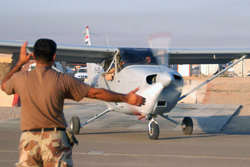 The environment is always on instructors’ minds, Garvin said. “Here if we have to land outside the wire, Farmer Joe is probably not going to be too keen to come out and help you, and he might hurt you. In the [United] States he might bring you a glass of sweet tea. We go out prepared for the worst, and hoping for the best.”
The environment is always on instructors’ minds, Garvin said. “Here if we have to land outside the wire, Farmer Joe is probably not going to be too keen to come out and help you, and he might hurt you. In the [United] States he might bring you a glass of sweet tea. We go out prepared for the worst, and hoping for the best.”
Shumaker agreed. “In the states you focus on how you’re going to get on the ground, and then you’re golden. In Iraq, that’s when your problems are just beginning. The thought that you may have to, in 100-degree heat, put the airplane down and run—in gear—to cover kept most of the guys going to the gym regularly.”
“We have to be prepared to land outside the wire and survive until we’re picked up and brought back to base,” Brauner explained. “We’re constantly aware that we’re in single-engine aircraft that are unarmored, and flying over areas where people could easily take shots at us with a rifle—and hit us.” Instructors check for battle damage—preflight, post flight, “and multiple times in flight.” They also minimize risk by avoiding populated areas.
Flights sometimes had to clear the traffic pattern because the ordnance disposal people were exploding captured weapons, Shumaker noted.
Logistical challenges
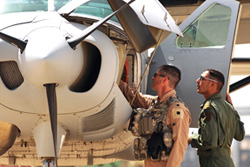 Shumaker was the first pilot in the squadron to arrive in Iraq. “The chance to set up a flight school is something you don’t get to do very often. In the states it would be a lot of work. But the supply challenge took what was already a challenging job and made it even more so. Even after nine months, we didn’t have a shredder to shred any sensitive documents.”
Shumaker was the first pilot in the squadron to arrive in Iraq. “The chance to set up a flight school is something you don’t get to do very often. In the states it would be a lot of work. But the supply challenge took what was already a challenging job and made it even more so. Even after nine months, we didn’t have a shredder to shred any sensitive documents.”
Capt. Chris Duffett arrived in Iraq in November 2007. “When we first got here, on the logistics side, there just wasn’t really much infrastructure at all.” He said he and four other instructors had to fight over a laptop to build a syllabus for the flying program, and they spent part of several days building furniture. “Now we’ve got a full-up flying training school.”
Duffett began training the initial class of three pilots. “We had to take them through ground school. It was the first time they’d had anything to do with aircraft,” he recalled. Less than a year later, those students were performing full VOR approach procedures with holds and three emergencies. “We focus on completing the mission, and as part of that there’s a lot of emphasis on emergencies.”
Shumaker said students occasionally would leave to check on their families. “The Iraqis were in a very precarious situation with their families and security. It was frustrating when you were doing training—just when the light bulb was coming on, they would go away for a couple of weeks. The vast majority were very proud to do what they were doing, and a joy to work with…but they couldn’t go home and tell the world about what they were doing for fear of endangering their families.”
The students
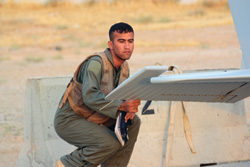 One of Shumaker’s students asked how their mistakes compared to those of American students he has trained. “They were the same. They had a hard time remembering to use right rudder. Getting them to look outside when they have a G1000. When you get right down to it, they make the same mistakes. They were very proud to hear that.”
One of Shumaker’s students asked how their mistakes compared to those of American students he has trained. “They were the same. They had a hard time remembering to use right rudder. Getting them to look outside when they have a G1000. When you get right down to it, they make the same mistakes. They were very proud to hear that.”
Communication has been a challenge across Iraq’s air force. “To be honest, the best progress that we tend to see is with the young students,” Brauner said. “But that being said, we’re in very close partnership with the Defense Language Institute and we have several of their instructors deployed with us.”
“When I was teaching a ground school class to the first four guys, I was teaching hemispheric altitude rules and when I said ‘odd’ and ‘even’ I saw they didn’t understand,” Duffett noted. His students had engineering backgrounds and knew the concepts, but not the English terms.
“We have to be able to teach and instruct in a variety of ways,” he said. “Here we usually have to follow up with a series of questions, to make sure they not only are hearing what we have to say, but that they’re putting it into the proper context.”
Military roots
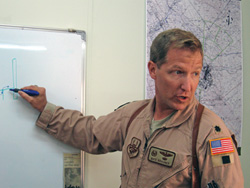 Lt. Col. Nate Brauner, commander of the 52nd Expeditionary Flying Training Squadron, presents a ground school lesson.
Lt. Col. Nate Brauner, commander of the 52nd Expeditionary Flying Training Squadron, presents a ground school lesson.
“Our program here is structured as a military flight training program,” Brauner explained. For Iraq’s new air force, his team set up the equivalent of a single-engine commercial pilot certificate with an instrument rating, generally following the current military syllabus but omitting low-level navigation and formation flying. “We put the emphasis on general handling, and navigation at a higher altitude—say, about 10,000 feet,” Brauner said. “The difference is primarily in the structure and pace of the training program here—and the threat environment.”
In addition to training new pilots, the Air Force instructors are training Iraqi instructor pilots. “All new pilots are getting IFR training,” Brauner said. “We’re training them to a higher level than they’ve had here in Iraq. Remember, the old Iraqi air force was a day/VFR-only operation.”
Eight G1000-equipped Cessna 172s are used for primary training. “It’s a marvelous tool for the students—sometimes too much of a tool,” Brauner said. “You walk out on the ramp here in Iraq and you have technology that’s better than what you find in a lot of FBOs in the United States.” After primary training, pilots upgrade to Cessna 208 Caravans with Garmin 430/530 navigators; G1000-equipped Caravans are on the way. Iraq’s air force uses the Caravans for transportation and logistical support, as well as intelligence, surveillance, and reconnaissance (ISR) missions.
Rotary-wing training is conducted by contractors. Bell Jet Ranger and OH–58 Kiowa trainers lead to slots flying UH–1 Hueys. “We’ll start everyone out in the same academics, then put them through a flight screening program in the 172s,” Brauner said. Iraq’s government will decide if pilots take a fixed- or rotary-wing path.
History
In 2005 the U.S. Air Force was asked to help with the rebuilding of Iraq’s air force, and the Coalition Air Force Training Team was created. “Since then it’s grown into an organization of about 350,” Brauner said.In 2006, there were only 750 people in Iraq’s air force. “As a result of the surge and as things started to calm down in Iraq, they had 950 people in the air force at the end of 2007,” Brauner said. By the summer of 2008 there were 1,900 people, and the year-end goal was 2,800. “By the end of 2009, with the processes we have in place, we’re confident that it’s going to be 6,000. It’s just a meteoric rise in the number of people.” The structure of its squadrons mimics a typical U.S. Air Force unit, and headquarters staff are in Baghdad.
The age of soldiers in Iraq’s fledgling air force is much younger—before, it had 149 pilots with only three under 40. “This allows us a golden period to put our fingerprints on the Iraqi air force, and to mold them into a Western-style air force,” Brauner said.
It takes about three years of training for a new pilot to become a mission-qualified co-pilot. “That’s a long lead time,” Brauner notes, adding that training for other functions—from aircraft maintenance to finance officer—also is under way. “If you can’t sustain the aircraft, and if you don’t have a sustainable logistics structure, that air force isn’t going to last after the life support is pulled off. That’s why we’re flying diesel aircraft.”
The unit started with a corner of a tent and a sawhorse, and aircraft parked on dirt. Now there are three Cessna 172 simulators and two each for the Caravan, Jet Ranger, and Huey II—and the aircraft are parked on concrete and matting. “It’s phenomenal the amount of building that’s going on out here,” he said. L3 and Cessna are providing aircraft maintenance, and CSC maintains the sims. “It’s a lot of work in this dusty environment.”
Unique mission
“The mission of the 321st Air Expeditionary Wing is unique in U.S. Air Force history, though it bears resemblance to previous American initiatives to train foreign airmen,” said Brig. Gen. Brooks L. Bash, the wing’s commander. After World War II, members of the wartime German Luftwaffe trained in the United States, and in the early 1960s, Air Force personnel conducted extensive training for Vietnamese airmen, both in the United States and in Vietnam—including primary flight training and instructor pilot training at Nha Trang.
“The challenges of a young democratic state have forced the 321 AEW to expand beyond the traditional advisory areas of primary flight training, tactics, and maintenance,” Bash said. “Another group of advisors is focused on building an air staff capable of steering its service into the future.”
Because Iraq doesn’t have the capability to refine avgas, Thielert diesel engines—which can burn JP-8, a readily available military fuel—were selected for the training. Replacement clutches for the Thielert engines were a problem last summer.
“There was a period of time in June when we were unable to conduct flight operations in the 172s because we were waiting for Thielert to provide clutches,” Brauner said. “Within 36 hours of picking them up at the factory, the first airplane was up and flying. That was an incredible logistical feat. That highlights what’s going on with logistics support here in the theater.”
The traffic pattern at Kirkuk sometimes amazed Shumaker. “Every now and then we’d be doing touch and goes, and there would be a three-ship of helicopters 50 feet to the side, coming at you opposite direction. You had the same kind of air traffic issues that you’d have in the states but they were taken to the next level,” he said. The use of classified position names—which frequently changed—made it harder for students to build a mental picture of the traffic. At any time the pattern might include large transports, smaller airplanes, helicopters, and unmanned aerial vehicles.
Ground-based navaids are pretty scarce in Iraq, Duffett said. “We do a lot of GPS training, especially in the instrument phase.” Most training flights are conducted at 10,000 feet, an altitude selected because of the unpressurized aircraft and Iraqi safety regulations. “An additional benefit is that it’s usually a little cooler,” Duffett added. Some mountainous areas in Iraq have minimum safe altitudes of 11,000 feet.
Brauner believes the program has made great progress. “When I came through on a site survey mission three years ago, and look at where 3 Squadron [the training squadron] and where the infrastructure is now—it’s amazing,” he said. Three pilots were about to graduate, 46 were in training, and six were in the instructor pilot program. “That number will be up to more than 100 in training six months from now,” he said, and the goal is 130 pilots a year in training. “We’re well on our way to that objective,” he said. “I have rarely seen a mission that’s been this successful during my time in the Air Force.”
U.S. Air Force photos by Technical Sgt. Jeffrey Allen, Lt. Col. Nate Brauner, and Master Sgt. Andrew Leonhard.
See “ Let’s Go Flying,” page 25 for a story on American soldiers learning to fly while overseas.


